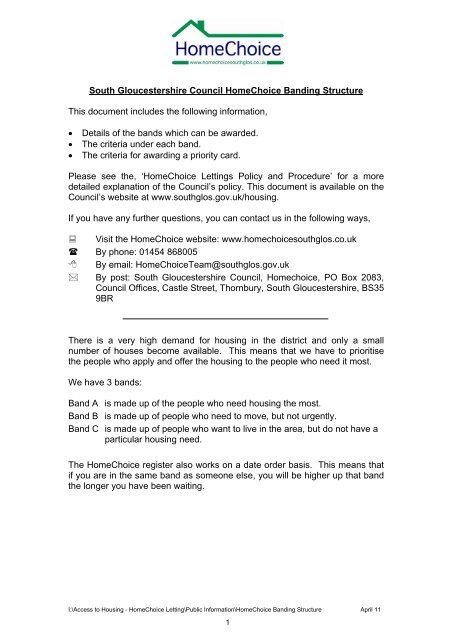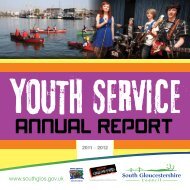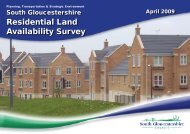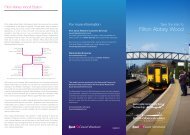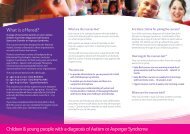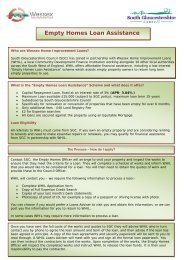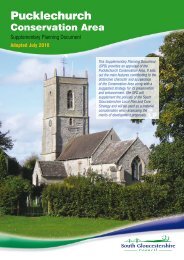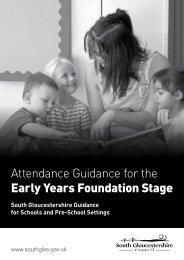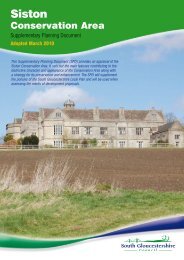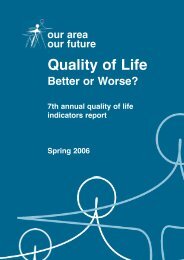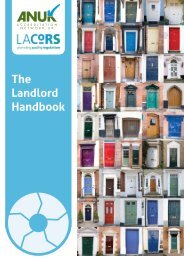South Gloucestershire Council HomeChoice Banding Structure This ...
South Gloucestershire Council HomeChoice Banding Structure This ...
South Gloucestershire Council HomeChoice Banding Structure This ...
You also want an ePaper? Increase the reach of your titles
YUMPU automatically turns print PDFs into web optimized ePapers that Google loves.
<strong>South</strong> <strong>Gloucestershire</strong> <strong>Council</strong> <strong>HomeChoice</strong> <strong>Banding</strong> <strong>Structure</strong><br />
<strong>This</strong> document includes the following information,<br />
• Details of the bands which can be awarded.<br />
• The criteria under each band.<br />
• The criteria for awarding a priority card.<br />
Please see the, ‘<strong>HomeChoice</strong> Lettings Policy and Procedure’ for a more<br />
detailed explanation of the <strong>Council</strong>’s policy. <strong>This</strong> document is available on the<br />
<strong>Council</strong>’s website at www.southglos.gov.uk/housing.<br />
If you have any further questions, you can contact us in the following ways,<br />
Visit the <strong>HomeChoice</strong> website: www.homechoicesouthglos.co.uk<br />
By phone: 01454 868005<br />
By email: <strong>HomeChoice</strong>Team@southglos.gov.uk<br />
By post: <strong>South</strong> <strong>Gloucestershire</strong> <strong>Council</strong>, Homechoice, PO Box 2083,<br />
<strong>Council</strong> Offices, Castle Street, Thornbury, <strong>South</strong> <strong>Gloucestershire</strong>, BS35<br />
9BR<br />
There is a very high demand for housing in the district and only a small<br />
number of houses become available. <strong>This</strong> means that we have to prioritise<br />
the people who apply and offer the housing to the people who need it most.<br />
We have 3 bands:<br />
Band A is made up of the people who need housing the most.<br />
Band B is made up of people who need to move, but not urgently.<br />
Band C is made up of people who want to live in the area, but do not have a<br />
particular housing need.<br />
The <strong>HomeChoice</strong> register also works on a date order basis. <strong>This</strong> means that<br />
if you are in the same band as someone else, you will be higher up that band<br />
the longer you have been waiting.<br />
I:\Access to Housing - <strong>HomeChoice</strong> Letting\Public Information\<strong>HomeChoice</strong> <strong>Banding</strong> <strong>Structure</strong> April 11<br />
1
Band A<br />
‣ Applicants accepted as homeless under Part VII of the Housing Act<br />
1996 (as amended by the Homeless Act 2002) and owed a duty by<br />
<strong>South</strong> <strong>Gloucestershire</strong> <strong>Council</strong>. <strong>This</strong> includes Agricultural workers as<br />
recommended by the Agricultural Dwelling House Advisory Committee.<br />
‣ Urgent housing need due to health or welfare circumstances (as<br />
assessed by the <strong>HomeChoice</strong> panel.<br />
‣ Under-occupation: Where the applicant is the tenant of a partner<br />
member, lives in <strong>South</strong> <strong>Gloucestershire</strong> and<br />
1. Under occupies their property by 2 or more bedrooms and is looking<br />
to move to a smaller property, or<br />
2. Who occupies a 2+ bedroom property and is looking to move to<br />
sheltered accommodation.<br />
‣ Applicants who are statutorily overcrowded as defined in part X of the<br />
Housing Act 1985.<br />
‣ Applicants living in accommodation where assessment by the Private<br />
Sector Housing Team has identified an actionable hazard under the<br />
Housing Health and Safety Rating system (Housing Act 2004), which is<br />
likely to have an immediate adverse effect on their health and which is<br />
not readily actionable under the provisions of the Act.<br />
‣ Applicants living in a <strong>South</strong> <strong>Gloucestershire</strong> supported housing scheme<br />
assessed as ready to move into independent accommodation by the<br />
housing provider. <strong>This</strong> will only apply where the <strong>Council</strong> and the<br />
housing provider have a service level agreement in place. <strong>This</strong> banding<br />
will also require that, where appropriate, arrangements have been made<br />
for post-tenancy support. All cases will be referred to the <strong>HomeChoice</strong><br />
Panel or, if applicable, the Young Persons <strong>HomeChoice</strong> Panel.<br />
‣ Applicants who have been looked after, fostered or accommodated by<br />
<strong>South</strong> <strong>Gloucestershire</strong> <strong>Council</strong>’s Children and Young Peoples’ Services<br />
and are ready for independent living.<br />
‣ Applicants who have the right to succeed to a tenancy on the death of a<br />
tenant but who require rehousing in more suitable accommodation.<br />
‣ Applicants who have been approved by <strong>South</strong> <strong>Gloucestershire</strong><br />
<strong>Council</strong>’s Family Placement Team to provide long term foster care and<br />
are currently in an inadequately sized property. The Family Placement<br />
team are social workers from the Children and Young People<br />
department of the <strong>Council</strong>.<br />
‣ Applicants who have multiple needs and meet several of the criteria in<br />
Band B, or where different members of the household have composite<br />
housing needs that meet criteria in Band B. <strong>This</strong> includes the needs of<br />
residential and non-residential carers. Band A would only be awarded<br />
following referral to the <strong>HomeChoice</strong> Panel.<br />
I:\Access to Housing - <strong>HomeChoice</strong> Letting\Public Information\<strong>HomeChoice</strong> <strong>Banding</strong> <strong>Structure</strong> April 11<br />
2
Band B<br />
‣ Housing need due to health or welfare circumstances.<br />
‣ Applicants in temporary, or insecure accommodation, who have<br />
received notice to leave.<br />
‣ Applicants who have received a possession order.<br />
‣ Applicants who are homeless, or with no fixed abode, but who do not<br />
meet the statutory requirements for homelessness under part VII of the<br />
Housing Act 1996 (as amended by the Homelessness Act 2002).<br />
‣ Applicants who have been placed in interim accommodation pending a<br />
homelessness decision.<br />
‣ Applicants living in separate households, but who wish to be rehoused<br />
together, where neither party has adequately sized accommodation to<br />
provide housing for the joint households.<br />
‣ Applicants living in tied accommodation, but wishing or needing to<br />
retire.<br />
‣ Applicants who are lacking bedrooms for the size of their household, but<br />
do not meet requirements for statutory overcrowding.<br />
‣ Applicants who have been offered full-time employment in the area and<br />
are unable to commute.<br />
‣ Applicants, who own their own home, in exceptional financial hardship,<br />
making it difficult to maintain their current home.<br />
‣ Applicants who need to move to a particular area to give or receive<br />
support where failure to meet that need would cause hardship.<br />
‣ Applicants lacking facilities, or sharing facilities with non-household<br />
members.<br />
‣ Relationship breakdown where a spouse or partner is living under the<br />
same roof.<br />
‣ Under-occupation where the applicant is the tenant of a partner<br />
member, resides in the district, under-occupies their property by 1<br />
bedroom and is looking to move to a smaller property, or who is looking<br />
to move from 1 bed general needs accommodation to sheltered<br />
accommodation.<br />
Band C<br />
‣ Other applicants wishing to move but do not fall in to any other<br />
category.<br />
‣ Applicants with a health or welfare need that is unlikely to be improved<br />
by alternative housing.<br />
‣ Applicants who have the financial capability to afford suitable alternative<br />
accommodation for their needs, including the market price of property or<br />
market rent for private landlord. <strong>This</strong> will override all other priorities that<br />
would place applicants in higher bands.<br />
‣ Applicants living outside of the <strong>Council</strong>’s area who do not meet the<br />
criteria for urgent housing through S213 of the Housing Act 1996 (as<br />
amended). <strong>This</strong> will override all other priorities that would place<br />
applicants in higher bands.<br />
I:\Access to Housing - <strong>HomeChoice</strong> Letting\Public Information\<strong>HomeChoice</strong> <strong>Banding</strong> <strong>Structure</strong> April 11<br />
3
Criteria for Assessing the Composite Housing Needs that may Confer<br />
Band A<br />
Band A can be awarded for the following reason,<br />
‘Applicants who have multiple needs and meet several of the criteria in Band<br />
B, or where different members of the household have composite housing<br />
needs that meet criteria in Band B. <strong>This</strong> includes the needs of residential and<br />
non-residential carers. Band A would only be awarded following referral to the<br />
<strong>HomeChoice</strong> Panel’.<br />
<strong>This</strong> can be separated out into two different sets of composite need:<br />
• Where several circumstances apply that, if taken individually, would not in<br />
themselves merit an urgent need to move, but, taken in combination,<br />
would confer a sufficient level of urgency to merit Band A.<br />
• Where several members of the household are experiencing their own level<br />
of difficulty that amounts to a higher level of difficulty being experienced by<br />
that household sufficient for them to be considered in urgent need of<br />
moving.<br />
The criteria listed under Band B (see 2.4) can be grouped together to reflect<br />
the fact that they arise from the same cause, or have similar effects. In order<br />
for Band A to be awarded, the equivalent of Band B needs must arise in three<br />
or more of the Groups as set out below. It is sufficient for one criteria within<br />
each group to be demonstrated.<br />
Group 1) Insecurity of tenure<br />
‣ Applicants in temporary or insecure accommodation who have received<br />
notice to leave.<br />
‣ Applicants who have received a possession order.<br />
‣ Applicants who are homeless or with no fixed abode but who do not meet<br />
the statutory requirements for homelessness under part VII of the Housing<br />
Act 1996 (as amended by the Homelessness Act 2002).<br />
‣ Applicants who have been placed in interim accommodation pending a<br />
homelessness decision.<br />
‣ Applicants living in tied accommodation but wishing or needing to retire.<br />
‣ Relationship breakdown where a spouse or partner is living under the<br />
same roof.<br />
‣ Applicants in exceptional financial hardship, making it difficult to maintain<br />
their current home.<br />
Group 2) Current accommodation unsuitable but non-urgent circumstances<br />
‣ Applicants who are lacking bedrooms for the size of their household but do<br />
not meet requirements for statutory overcrowding.<br />
‣ Applicants lacking facilities, or sharing facilities with non-household<br />
members.<br />
I:\Access to Housing - <strong>HomeChoice</strong> Letting\Public Information\<strong>HomeChoice</strong> <strong>Banding</strong> <strong>Structure</strong> April 11<br />
4
‣ Applicants living in separate households but who wish to be rehoused<br />
together, where neither party has adequately sized accommodation to<br />
provide housing for the joint households.<br />
Group 3) Accommodation release to enable rental stock to be made available<br />
‣ Under-occupation where the applicant is the tenant of a partner member,<br />
resides in the district, under-occupies their property by 1 bedroom and is<br />
looking to move to a smaller property, or who is looking to move from 1<br />
bed general needs accommodation to sheltered accommodation.<br />
Group 4) Social, Health or Welfare circumstances<br />
‣ Housing need due to health or welfare circumstances.<br />
‣ Applicants who have been offered full-time employment in an area and are<br />
unable to commute.<br />
‣ Applicants who need to move to a particular area to give or receive<br />
support where failure to meet that need would cause hardship.<br />
I:\Access to Housing - <strong>HomeChoice</strong> Letting\Public Information\<strong>HomeChoice</strong> <strong>Banding</strong> <strong>Structure</strong> April 11<br />
5
Priority cards<br />
For a very small number of people, their circumstances will mean they need to<br />
move as soon as possible. In this situation, we can award a ‘priority card’.<br />
<strong>This</strong> gives the household priority over everyone else and will usually be valid<br />
for 12 weeks. All applicants awarded a priority card will receive advice about<br />
the size and the type of property they may bid for.<br />
Priority cards may be awarded in the case of:<br />
‣ Substantial and/or life threatening health problems directly linked to an<br />
applicant’s housing situation where their current property cannot be<br />
adapted to meet their needs. <strong>This</strong> includes (but is not limited to) any of the<br />
following:<br />
Those who have developed severe mobility problems which prevent<br />
access to essential areas of their current accommodation e.g. permanent,<br />
complete wheelchair use, use of walking frame constantly, disabled for<br />
whatever reason and unable to negotiate stairs (currently in property with<br />
upstairs facilities).<br />
‣ Applicants with severe and enduring mental health problems being<br />
discharged from inpatient psychiatric services who would be at risk, or a<br />
risk to others, without settled accommodation, are not able to find suitable<br />
accommodation and an intensive care package has been arranged to<br />
support the applicant in independent living.<br />
‣ Hospital discharge/urgent health need: Where the applicant, or a member<br />
of their household, has a progressive or chronic health condition and is<br />
unable to meet their own housing needs and where their existing<br />
accommodation cannot meet or be made to meet their housing needs. A<br />
care plan for the relevant person must have been devised.<br />
‣ Those with terminal/end stage life expectancy AND it must be<br />
demonstrated that the patient’s current housing is unsuitable because of<br />
their illness and that it essentially affects their mobility and prevents them<br />
accessing facilities or carer’s ability to provide care. For example, for those<br />
with severe chronic cardiac/respiratory disease that requires home oxygen<br />
use, the patient will be breathless at rest and unable to mobilise due to<br />
internal stairs.<br />
Discretionary decisions to be made by the panel on a case by case basis<br />
with the power to turn down applications if reports suggest short life<br />
expectancy (less than 6 months).<br />
‣ Whose welfare needs are such that the protection of vulnerable adults or<br />
children is only possible if the household is re-housed. <strong>This</strong> includes (but is<br />
not limited to) any of the following:<br />
Where the present housing circumstances have deteriorated or are likely<br />
to deteriorate to such an extent as to place family members, particularly<br />
children, at risk or in need of residential care.<br />
‣ Applicants who are acting as a police witness where the police have<br />
requested immediate re-housing under the witness protection scheme.<br />
I:\Access to Housing - <strong>HomeChoice</strong> Letting\Public Information\<strong>HomeChoice</strong> <strong>Banding</strong> <strong>Structure</strong> April 11<br />
6
‣ Where the applicant, or a member of their household is subject to severe<br />
harassment, racial harassment, threats of violence, or actual violence, or<br />
threats of physical, emotional, or sexual abuse and it appears that the<br />
problems can only be resolved by an immediate move.<br />
‣ Demolition or prohibition order where the Private Sector Housing Team<br />
advise that, under the Housing Health and Safety Rating system (Housing<br />
Act 2004) category 1 hazards exist that cannot be rectified.<br />
‣ Permanent decant: where the applicant is the tenant of a partner landlord<br />
and requires a permanent move to enable redevelopment or major<br />
refurbishment.<br />
I:\Access to Housing - <strong>HomeChoice</strong> Letting\Public Information\<strong>HomeChoice</strong> <strong>Banding</strong> <strong>Structure</strong> April 11<br />
7


